Starting from:
$12.95
World War I: london Times Documentary History of World War I 11 Volumes - Download
World War I: london Times Documentary History of World War I
11 Volumes
5,900 pages, in 11 volumes of the Times Documentary History of the War.
The London Times between 1917 and 1920 published 11 volumes of transcripts of documents related to World War I.
Volumes 1 & 2 Diplomatic Part 1 & 2
The first and second Diplomatic volumes deal with the outbreak of the War and embrace the documentary records of events, negotiations, correspondence, and important public utterances emanating from Great Britain, France, Russia, Belgium, Serbia, Germany, Austria-Hungary, Japan, and in one instance Italy. Foreign documents are given in English in official translations.
The whole of the first volume and more than half the second are filled by the British Blue-book and the official translations of the French Yellow-book, the Russian Orangebook, the Belgian Grey-book, the Serbian Blue-book, the German White-book, and the Austro-Hungarian Red-book, which contain the dispatches published by the various belligerent Powers to justify or explain their proceedings during the critical period that led up to the War.
The papers in the remainder of the second volume are miscellaneous in character. They include certain Japanese documents among these an important speech delivered by Baron Kato, the Foreign Minister, in the Imperial Diet at Tokyo, the published correspondence of King George V. with the President of the French Republic and with the Czar; the British notifications of a State of War; a series of German controversial documents regarding Anglo-Belgian relations, together with the British and Belgian replies; a similar series bearing on the action of Germany before the War; Signer Giolitti's notable speech of December 5, 1914, in the Italian Chamber, throwing light upon the attitude of Italy in separating herself from her allies; the considered utterances of British statesmen, including Sir Edward Grey's important speech on the origin and main issue of the War, delivered at the Bechstein Hall in March, 1915 ; certain Foreign Addresses, Proclamations and Messages; and, finally, the text, in whole or in part, of Treaties mentioned in the course of the Correspondence.
Volume 3 & 4 - Naval Part 1 & 2
This volume begins the Naval division of The Times Documentary History of the War. The documents contained in it are of a distinctly naval character. They deal either with specific naval events or with questions of policy and acts of State having a direct bearing on the conduct of the War on the seas.
The arrangement of the volume is, in the main, chronological, each event being recorded either under the date on which it occurred, or under that on which it was first mentioned in any public document, official or unofficial. The source of each document is, as a rule, given in the margin, as also its date, unless the latter is found in the document itself. The month to which the several documents refer is indicated at the inner top corner of each left-hand page, and the year at the corresponding inner corner of the page on the right.
Documents include:
A list of enemy merchant vessels detained in British and Allied ports, or captured at sea by His Majesty's armed forces and those of the Allies, was published periodically in the London Gazette. These lists are given in extension at the end of each month.
Admiralty Monthly Orders, a collection of all the Orders issued to the Fleet from time to time during the preceding month. These Orders, being issued solely for the use of the Fleet, were not commonly made public, some of them being of a confidential character, others of purely technical and professional interest. By the courtesy of the British Admiralty, the Editors had access to them, and, subject to the approval of the Admiralty in each particular case, were allowed to print such of them as seemed to be invested with general or historical interest. Under the heading "Admiralty Monthly Orders," a selection of these Orders will be found at the end of the record of each month represented in this volume.
Volume 5 Military Part 1
Contains documents dealing with the Military aspects of the War The first volume covers the year 1914 in respect of Royal Proclamations and Orders, and Public Notices relating to Military affairs ; Extracts from Army Orders connected with the War; Appointments and Promotions of general officers; Parliamentary Proceedings and Public Speeches; and proclamations of and exchanges of Messages between the Belligerent Powers on Military matters. In the sub-section devoted to the Proclamations of Powers hostile to Great Britain, one of the aims kept in view is to show by characteristic examples a class of document which is countless in number, but the whole of which could not be obtained.
Documents cover: The use of illegal ammunition by the enemy is illustrated by a number of documents dealing with operations in 1914. The question of the violation of frontiers before the war is also dealt with. Sir John French's dispatches issued in 1914, and those relating to the operations around Antwerp, are included, and these are illustrated by maps. Orders and Reports of British Generals, and a list of Victoria Crosses gazetted in 1914 conclude the volume.
In the Appendix will be found the official English text of The Hague Declarations of 1899 respecting Expanding Bullets and Asphyxiating Gases ; of the Geneva Convention of 1906 ; and of the Hague Conventions of 1907 concerning the Opening of Hostilities and the Laws and Customs of War on Land.
Volume 6 - Overseas
This volume contains documents which, with the exception of two included in the Appendix, relate exclusively to the Dominion of Canada. Apart from those in the Appendix, these documents cover the period between the outbreak of the Great War and the departure of the First Canadian Contingent for England.
The material is arranged as follows. First, the Correspondence between the Home and Canadian Governments during August and September 1914, and the cablegrams which passed between Sir Robert Borden and Mr. (now Sir G. H.) Perley, who was acting as Canadian High Commissioner in London. Next come Orders in Council and Proclamations of the Canadian Government in August and September 1914, a selection from the Debates of the Dominion Parliament in its Extraordinary Session of August 1914, some of the War Statutes enacted, non-Parliamentary Speeches and Messages of Canadian statesmen, and other documents showing the state of public opinion in the Dominion from the end of July to the end of September 1914. In the last section will be found material relating to the Canadian Expeditionary Force. In addition to documents relating to its composition, particulars are given of contracts which had to be made for its equipment.
In an Appendix will be found the reports of Sir John French and Sir Ian Hamilton on the Canadian Military Forces, dated respectively July 5, 1910, and July 30, 1913; also the report of Major-General Sir P. H. N. Lake, dated September 14, 1910, upon the best method of giving effect to the recommendations of Sir John French ; the Correspondence relating to the proposed formation of an Imperial General Staff and the Papers laid before the Imperial Conference, 1911 : Naval and Military Defence. The two last-mentioned documents relate not only to Canada but to other of the self-governing Dominions.
Volume 7 - Naval Part 3
Additional Naval documents from January and February 1915.
Volume 8 - Military Part 2
This volume continues the publication of documents dealing with the Military aspects of the War in 1914. Dispatches from British Eyewitnesses and French and Belgian Official and semi-Official Reports illustrate the campaign in the West in that year. Dispatches and Communiques dealing with the Turkish campaign of 1914 are prefaced by a selection from the Turkish Papers, in so far as they are concerned with Military matters. Then follows material relating to the Japanese operations at Kiao-chau, and extracts from the Correspondence and dealing with the capture of German Pacific Possessions by Expeditionary Forces from Australia and New Zealand.
Volume 9 - Diplomatic Part 3
The contents of this volume fall into three groups. The first relates, as did the two previous volumes in the Diplomatic division of this work, to the outbreak of the war (pp. 1-63) ; the second concerns the rupture with Turkey (pp. 64-309); the third consists of the second Belgian Grey Book, a miscellaneous collection of dispatches and reports dealing in part with these same two subjects, but by no means confined to them (pp. 310-501).
In the first group the chief item is Prince Lichnowsky's My Mission to London, 1912-1914, of which a special translation has been made (pp. 1-39). This belongs to the earliest period, although it was not published until the spring of 1918. The next two items, an article from the North German Gazette of October 12, 1917 (pp. 40-46), and a passage from Herr von Bethmann Hollweg's speech in the Reichstag of August 19, 1915 (pp. 47-48), supply information respecting telegrams that passed between Berlin and Vienna in July 1914. The original German text of the instructions embodying the demand for the surrender of Toul and Verdun (p. 49) has been supplied through the courtesy of the French Foreign Office. M. Sazonof's speech in the Duma of August 8, 1914 (pp. 52-55), is taken from a Russian official source which was not available when the first two volumes of The Times Documentary History of the War were prepared. The text of the German Emperor's telegram to President Wilson (pp. 56-58) is copied by permission from the facsimile in Mr. James W. Gerard's My Four Years in Germany. Mr. Bonar Law's letter promising support to Mr. Asquith's Government (pp. 59-60), and certain official British statements (pp. 61-63), conclude this group.
Volume 10 - Overseas Part 2
The first of the volumes in the Overseas Division of The Times Documentary History Of The War related exclusively to Canada and covered the period between the outbreak of the Great War and the departure for England, at the end of September 1914, of the First Canadian Contingent.
In this, the second volume of the series, the activities during the same period of Newfoundland, Australia, and New Zealand are exhibited. In the case of Newfoundland, the important Report of the Governor, dated March 31, 1915, dealing with events between August 12, 1914, and the end of March 1915, has been included. In an Appendix will be found the Report of the Committee of Imperial Defence upon a General Scheme of Defence for Australia, published in August, 1906 ; Lord Kitchener's Memorandum on the Defence of Australia of February 12, 1910 ; the Memorandum by the Australian Chief of the General Staff and of the Commonwealth Section of the Imperial General Staff of July 8, 1910 ; the greater part of the Reports, dated respectively April 24, 1914, and June 4, 1914, of Sir Ian Hamilton on the Military Forces of Australia and New Zealand ; and lastly, part of Admiral Sir Reginald Henderson's Recommendations of March 1, 1911, in regard to the Naval Forces of Australia.
By perusing these, and the documents relating to Australia and New Zealand, included in other volumes of the Documentary History, the reader will be able properly to appreciate the gigantic efforts made by Australia and New Zealand after the outbreak of the war. The Report of the Committee of Imperial Defence, also, lucidly explains the British Naval Strategy in 1906, while the Memorandum of Lord Kitchener and the Reports of Sir Ian Hamilton are of peculiar interest because of the distinguished part played by their authors after hostilities had commenced.
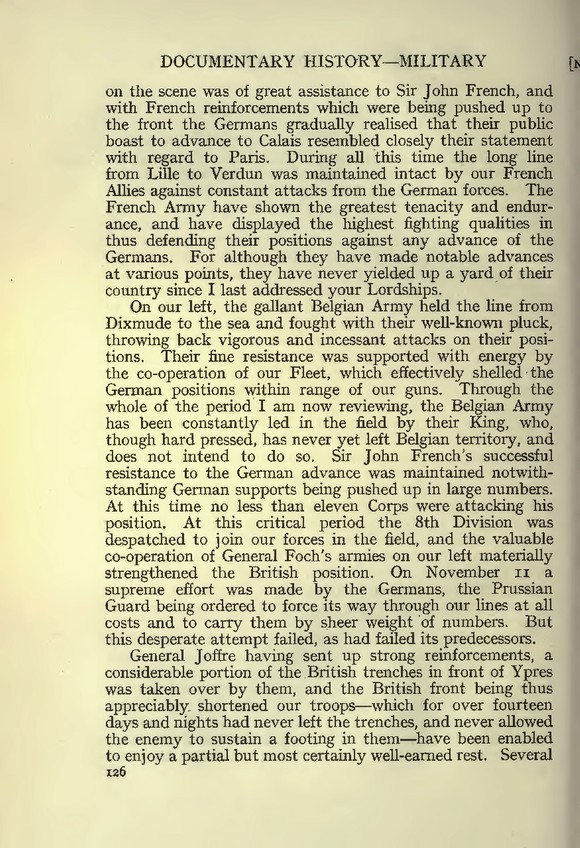
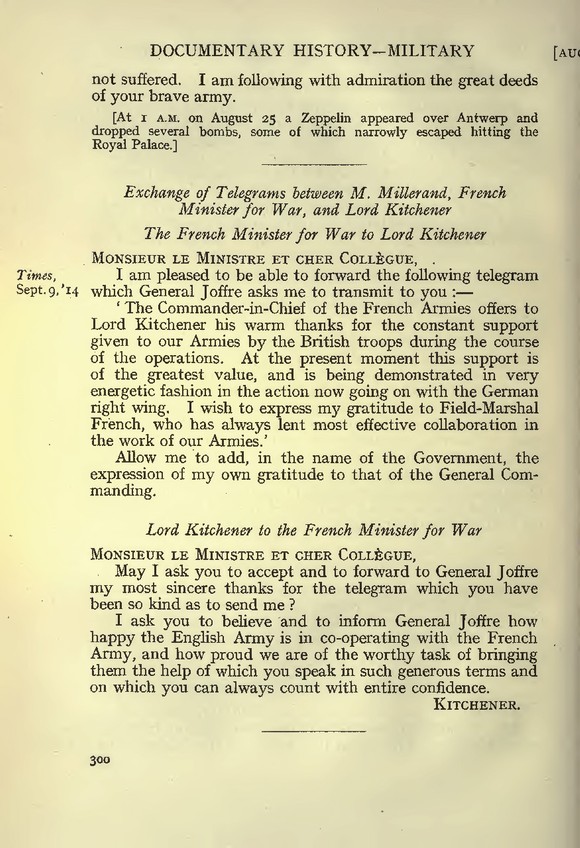
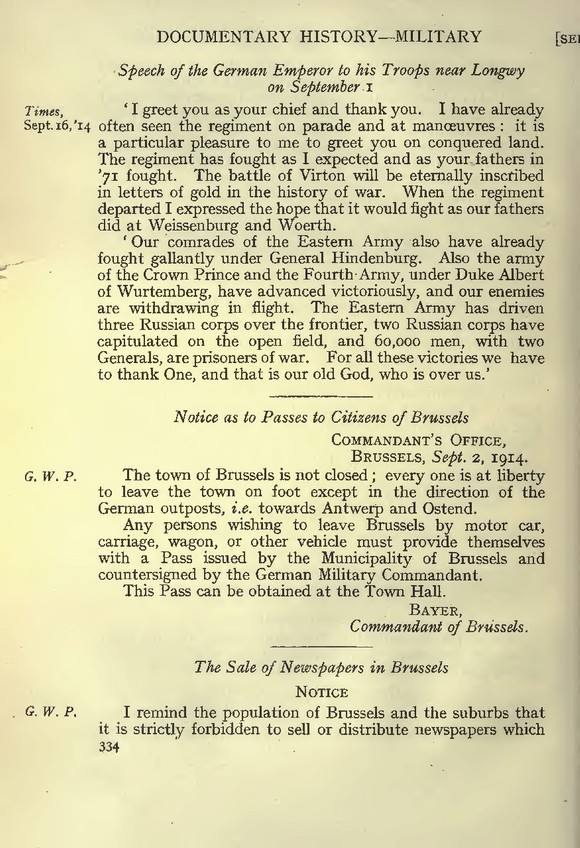


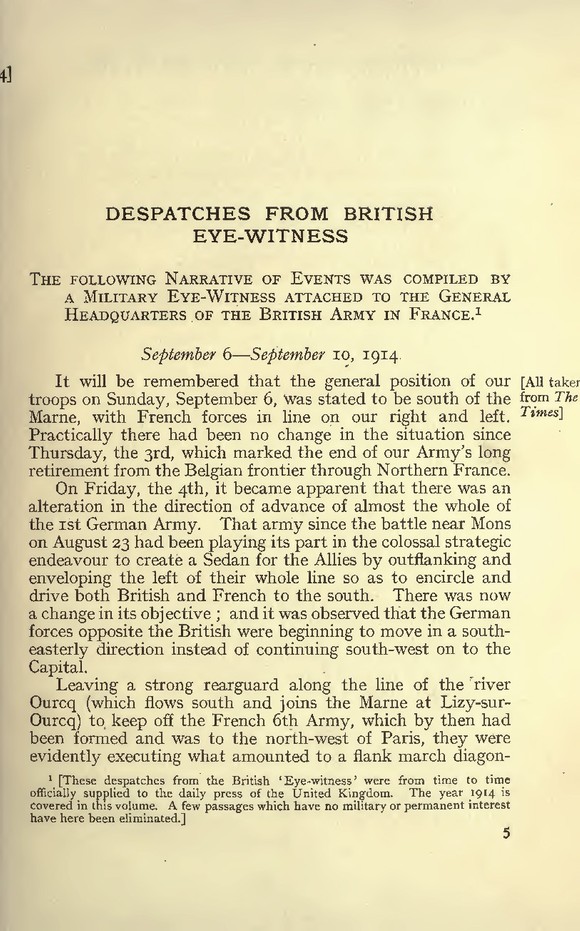
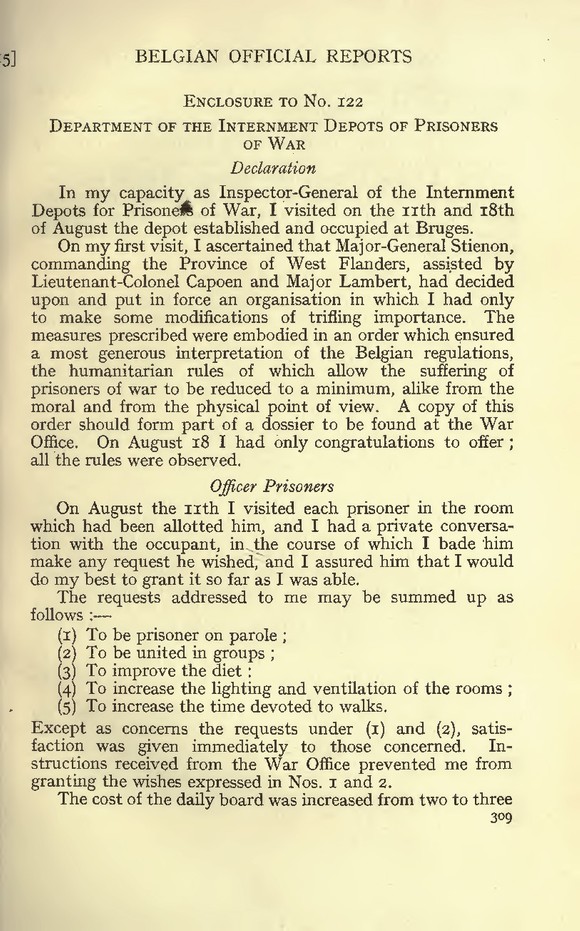


11 Volumes
5,900 pages, in 11 volumes of the Times Documentary History of the War.
The London Times between 1917 and 1920 published 11 volumes of transcripts of documents related to World War I.
Volumes 1 & 2 Diplomatic Part 1 & 2
The first and second Diplomatic volumes deal with the outbreak of the War and embrace the documentary records of events, negotiations, correspondence, and important public utterances emanating from Great Britain, France, Russia, Belgium, Serbia, Germany, Austria-Hungary, Japan, and in one instance Italy. Foreign documents are given in English in official translations.
The whole of the first volume and more than half the second are filled by the British Blue-book and the official translations of the French Yellow-book, the Russian Orangebook, the Belgian Grey-book, the Serbian Blue-book, the German White-book, and the Austro-Hungarian Red-book, which contain the dispatches published by the various belligerent Powers to justify or explain their proceedings during the critical period that led up to the War.
The papers in the remainder of the second volume are miscellaneous in character. They include certain Japanese documents among these an important speech delivered by Baron Kato, the Foreign Minister, in the Imperial Diet at Tokyo, the published correspondence of King George V. with the President of the French Republic and with the Czar; the British notifications of a State of War; a series of German controversial documents regarding Anglo-Belgian relations, together with the British and Belgian replies; a similar series bearing on the action of Germany before the War; Signer Giolitti's notable speech of December 5, 1914, in the Italian Chamber, throwing light upon the attitude of Italy in separating herself from her allies; the considered utterances of British statesmen, including Sir Edward Grey's important speech on the origin and main issue of the War, delivered at the Bechstein Hall in March, 1915 ; certain Foreign Addresses, Proclamations and Messages; and, finally, the text, in whole or in part, of Treaties mentioned in the course of the Correspondence.
Volume 3 & 4 - Naval Part 1 & 2
This volume begins the Naval division of The Times Documentary History of the War. The documents contained in it are of a distinctly naval character. They deal either with specific naval events or with questions of policy and acts of State having a direct bearing on the conduct of the War on the seas.
The arrangement of the volume is, in the main, chronological, each event being recorded either under the date on which it occurred, or under that on which it was first mentioned in any public document, official or unofficial. The source of each document is, as a rule, given in the margin, as also its date, unless the latter is found in the document itself. The month to which the several documents refer is indicated at the inner top corner of each left-hand page, and the year at the corresponding inner corner of the page on the right.
Documents include:
A list of enemy merchant vessels detained in British and Allied ports, or captured at sea by His Majesty's armed forces and those of the Allies, was published periodically in the London Gazette. These lists are given in extension at the end of each month.
Admiralty Monthly Orders, a collection of all the Orders issued to the Fleet from time to time during the preceding month. These Orders, being issued solely for the use of the Fleet, were not commonly made public, some of them being of a confidential character, others of purely technical and professional interest. By the courtesy of the British Admiralty, the Editors had access to them, and, subject to the approval of the Admiralty in each particular case, were allowed to print such of them as seemed to be invested with general or historical interest. Under the heading "Admiralty Monthly Orders," a selection of these Orders will be found at the end of the record of each month represented in this volume.
Volume 5 Military Part 1
Contains documents dealing with the Military aspects of the War The first volume covers the year 1914 in respect of Royal Proclamations and Orders, and Public Notices relating to Military affairs ; Extracts from Army Orders connected with the War; Appointments and Promotions of general officers; Parliamentary Proceedings and Public Speeches; and proclamations of and exchanges of Messages between the Belligerent Powers on Military matters. In the sub-section devoted to the Proclamations of Powers hostile to Great Britain, one of the aims kept in view is to show by characteristic examples a class of document which is countless in number, but the whole of which could not be obtained.
Documents cover: The use of illegal ammunition by the enemy is illustrated by a number of documents dealing with operations in 1914. The question of the violation of frontiers before the war is also dealt with. Sir John French's dispatches issued in 1914, and those relating to the operations around Antwerp, are included, and these are illustrated by maps. Orders and Reports of British Generals, and a list of Victoria Crosses gazetted in 1914 conclude the volume.
In the Appendix will be found the official English text of The Hague Declarations of 1899 respecting Expanding Bullets and Asphyxiating Gases ; of the Geneva Convention of 1906 ; and of the Hague Conventions of 1907 concerning the Opening of Hostilities and the Laws and Customs of War on Land.
Volume 6 - Overseas
This volume contains documents which, with the exception of two included in the Appendix, relate exclusively to the Dominion of Canada. Apart from those in the Appendix, these documents cover the period between the outbreak of the Great War and the departure of the First Canadian Contingent for England.
The material is arranged as follows. First, the Correspondence between the Home and Canadian Governments during August and September 1914, and the cablegrams which passed between Sir Robert Borden and Mr. (now Sir G. H.) Perley, who was acting as Canadian High Commissioner in London. Next come Orders in Council and Proclamations of the Canadian Government in August and September 1914, a selection from the Debates of the Dominion Parliament in its Extraordinary Session of August 1914, some of the War Statutes enacted, non-Parliamentary Speeches and Messages of Canadian statesmen, and other documents showing the state of public opinion in the Dominion from the end of July to the end of September 1914. In the last section will be found material relating to the Canadian Expeditionary Force. In addition to documents relating to its composition, particulars are given of contracts which had to be made for its equipment.
In an Appendix will be found the reports of Sir John French and Sir Ian Hamilton on the Canadian Military Forces, dated respectively July 5, 1910, and July 30, 1913; also the report of Major-General Sir P. H. N. Lake, dated September 14, 1910, upon the best method of giving effect to the recommendations of Sir John French ; the Correspondence relating to the proposed formation of an Imperial General Staff and the Papers laid before the Imperial Conference, 1911 : Naval and Military Defence. The two last-mentioned documents relate not only to Canada but to other of the self-governing Dominions.
Volume 7 - Naval Part 3
Additional Naval documents from January and February 1915.
Volume 8 - Military Part 2
This volume continues the publication of documents dealing with the Military aspects of the War in 1914. Dispatches from British Eyewitnesses and French and Belgian Official and semi-Official Reports illustrate the campaign in the West in that year. Dispatches and Communiques dealing with the Turkish campaign of 1914 are prefaced by a selection from the Turkish Papers, in so far as they are concerned with Military matters. Then follows material relating to the Japanese operations at Kiao-chau, and extracts from the Correspondence and dealing with the capture of German Pacific Possessions by Expeditionary Forces from Australia and New Zealand.
Volume 9 - Diplomatic Part 3
The contents of this volume fall into three groups. The first relates, as did the two previous volumes in the Diplomatic division of this work, to the outbreak of the war (pp. 1-63) ; the second concerns the rupture with Turkey (pp. 64-309); the third consists of the second Belgian Grey Book, a miscellaneous collection of dispatches and reports dealing in part with these same two subjects, but by no means confined to them (pp. 310-501).
In the first group the chief item is Prince Lichnowsky's My Mission to London, 1912-1914, of which a special translation has been made (pp. 1-39). This belongs to the earliest period, although it was not published until the spring of 1918. The next two items, an article from the North German Gazette of October 12, 1917 (pp. 40-46), and a passage from Herr von Bethmann Hollweg's speech in the Reichstag of August 19, 1915 (pp. 47-48), supply information respecting telegrams that passed between Berlin and Vienna in July 1914. The original German text of the instructions embodying the demand for the surrender of Toul and Verdun (p. 49) has been supplied through the courtesy of the French Foreign Office. M. Sazonof's speech in the Duma of August 8, 1914 (pp. 52-55), is taken from a Russian official source which was not available when the first two volumes of The Times Documentary History of the War were prepared. The text of the German Emperor's telegram to President Wilson (pp. 56-58) is copied by permission from the facsimile in Mr. James W. Gerard's My Four Years in Germany. Mr. Bonar Law's letter promising support to Mr. Asquith's Government (pp. 59-60), and certain official British statements (pp. 61-63), conclude this group.
Volume 10 - Overseas Part 2
The first of the volumes in the Overseas Division of The Times Documentary History Of The War related exclusively to Canada and covered the period between the outbreak of the Great War and the departure for England, at the end of September 1914, of the First Canadian Contingent.
In this, the second volume of the series, the activities during the same period of Newfoundland, Australia, and New Zealand are exhibited. In the case of Newfoundland, the important Report of the Governor, dated March 31, 1915, dealing with events between August 12, 1914, and the end of March 1915, has been included. In an Appendix will be found the Report of the Committee of Imperial Defence upon a General Scheme of Defence for Australia, published in August, 1906 ; Lord Kitchener's Memorandum on the Defence of Australia of February 12, 1910 ; the Memorandum by the Australian Chief of the General Staff and of the Commonwealth Section of the Imperial General Staff of July 8, 1910 ; the greater part of the Reports, dated respectively April 24, 1914, and June 4, 1914, of Sir Ian Hamilton on the Military Forces of Australia and New Zealand ; and lastly, part of Admiral Sir Reginald Henderson's Recommendations of March 1, 1911, in regard to the Naval Forces of Australia.
By perusing these, and the documents relating to Australia and New Zealand, included in other volumes of the Documentary History, the reader will be able properly to appreciate the gigantic efforts made by Australia and New Zealand after the outbreak of the war. The Report of the Committee of Imperial Defence, also, lucidly explains the British Naval Strategy in 1906, while the Memorandum of Lord Kitchener and the Reports of Sir Ian Hamilton are of peculiar interest because of the distinguished part played by their authors after hostilities had commenced.









1 file (399.3MB)



